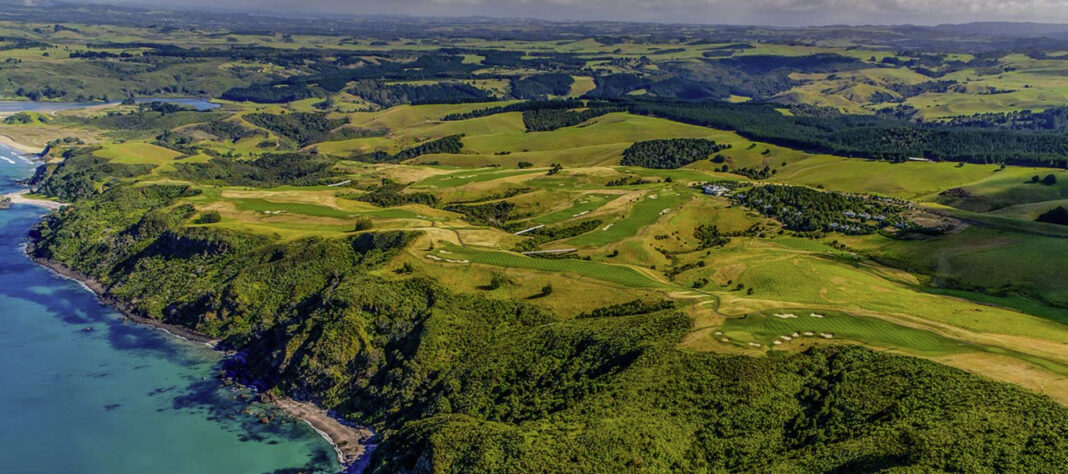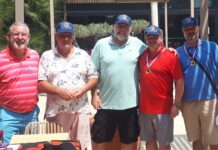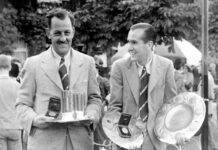
CAPE KIDNAPPERS golf course, New Zealand, is named after an attempt by the local Maori to kidnap a crew member from Captain Cook’s ship, the Endeavour, in 1769. Situated on the Hawkes Bay peninsula, the front nine is set amid rolling farmland, the back nine juts out over the Pacific Ocean.
At the 12th and 15th holes golfers must play right out to the edge, and leap from the end of one ridge to the next. The headland is a breeding site for 3,000 pairs of gannets, and players are reminded nesting birds do not like loud noises, so if you fell off the 140 metre cliffs you would be permitted only a whispered “*****!”
ENGLAND’s LOTTIE WOAD delivered an impressive victory at the Women’s Scottish Open. The only British contestant on the leaderboard, her five birdies and one bogey – just her third in 72 holes – took her to a 68 and 21 under to clinch the tournament.
Entering the final round at Dundonald Links with a two-shot lead she held her nerve to keep the chasing pack at bay. Not the first time Britain has triumphed in battle with the help of woad.
THE BETHPAGE BLACK, host course of September’s Ryder Cup (26-28th) is the most testing of the five courses at Bethpage State Park, Farmingdale, New York. It has a sign saying, “The Black is an extremely difficult course which we recommend only for highly skilled golfers.”
At the 2002 U.S. Open only Tiger Woods broke par, while in 2009, just five players finished the week in red figures.
It’s long, 7,459 yards, with multi-tiered greens, narrow fairways, deep rough and brutal bunkers. One reviewer, a 9 handicapper who shot 93 (+22) commented: “There are several long par-4s with fairways that run out 50 yds before the green, so you have to decide if you’re laying up to the end of the fairway or going for it from 180 yds out.”
There are basic trolleys, but it’s a hilly, tiring course. As for the crowds, ask Sergio, who lost his cool in 2002, or Greg Norman, who challenged one fan to a fight in the parking lot. It will be a miracle if the Ryder Cup ends without a punch-up.
 HOWEVER TALENTED they may be, Open winners nowadays lack a certain charisma. When the 1951 Open was held at Royal Portrush the winner was Max Faulkner from Sussex, nicknamed “The clown prince of golf” who delighted the crowds with his trick shots, and once walked from green to tee on his hands, claiming it helped the blood flow to his brain.
HOWEVER TALENTED they may be, Open winners nowadays lack a certain charisma. When the 1951 Open was held at Royal Portrush the winner was Max Faulkner from Sussex, nicknamed “The clown prince of golf” who delighted the crowds with his trick shots, and once walked from green to tee on his hands, claiming it helped the blood flow to his brain.
He played with mismatched clubs and a home-made putter, and favoured plus fours in rainbow colours, which did not go down at all well with the R & A.
After Max Faulkner’s win people asked Bernard Darwin if he had managed to get a word with the Champion. “My readers,” said Darwin, “are interested in what I think about his win, not what he thinks.”
THE WALKER CUP was introduced after WW1 to ‘Strengthen Understanding and Friendship’ between the British and American golf associations.
Named after the then USGA President George Herbert Walker (George Dubya’s great grandpappy) the first 10-man amateur tournament took place in 1922 at National Golf Links, New York. The US won, 8-4.
This year the 50th biennial Walker Cup will be played on 6th-7th September at Cypress Point, California.
America won last time at St. Andrews, their fourth victory in a row, beating GB&I by 14.5-11.5. so ‘Understanding and Friendship’ may be through gritted teeth if they do it again.
FRANK WENT OFF to golf forgetting it was his wedding anniversary. His wife Mona told him, “Right, tomorrow there had better be something in the drive for me that goes from 0 to 100 in 2 seconds flat.” The next morning Mona found a package in the drive. It contained a set of bathroom scales. Frank has told his pals at the golf club that he walked into a door.
Until next time: Happy Golfing.
Contact Mick for regripping and repairs. Tel. 638 859 475.





